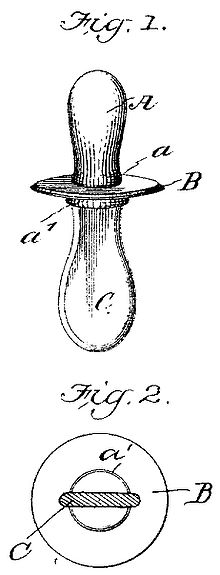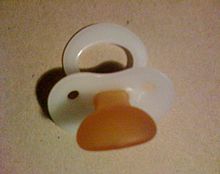- Pacifier
-
This article is about the baby pacifier. For other uses, see Pacifier (disambiguation).
A pacifier (known as a dummy or soother in some countries) is a rubber, plastic, or silicone nipple given to an infant or other young child to suck upon. In its standard appearance it has a teat, mouth shield, and handle. The mouth shield and/or the handle is large enough to avoid the danger of the child choking on it or swallowing it.
Contents
History
In England in the 17th–19th centuries, a coral meant a teething toy made of coral, ivory or bone, often mounted in silver as the handle of a rattle.[1] A museum curator has suggested that these substances were used as "sympathetic magic"[2] and that the animal bone could symbolize animal strength to help the child cope with pain.
Pacifiers were a development of hard teething rings, but they were also a substitute for the softer sugar tits, sugar-teats or sugar-rags[3] which had been in use in 19th century America. A writer in 1873 described a "sugar-teat" made from "a small piece of old linen" with a "spoonful of rather sandy sugar in the centre of it", "gathered ... up into a little ball" with a thread tied tightly around it.[4] Rags with foodstuffs tied inside were also given to babies in many parts of Northern Europe and elsewhere. In some places a lump of meat or fat was tied in cloth, and sometimes the rag was moistened with brandy. German-speaking areas might use Lutschbeutel: cloth wrapped round sweetened bread, or maybe poppy-seeds. A Madonna and child painted by Dürer in 1506[5] shows one of these tied-cloth "pacifiers" in the baby's hand.[6]
Pacifiers were settling into their modern form around 1900 when the first teat, shield and handle design was patented in the US as a "baby comforter".[7] Rubber had been used in flexible teethers sold as "elastic gum rings" for British babies in the mid-19th century,[8] and also used for feeding-bottle teats. In 1902 Sears Roebuck advertised a "new style rubber teething ring, with one hard and one soft nipple",[9] and in 1909 someone calling herself "Auntie Pacifier" wrote to the New York Times to warn of the "menace to health" (she meant dental health) of "the persistent, and, among poorer classes, the universal sucking of a rubber nipple sold as a 'pacifier'."[10] In England too, dummies were seen as something the "poorer classes" would use, and associated with poor hygiene. In 1914 a London doctor complained about "the dummy teat": "If it falls on the floor it is rubbed momentarily on the mother's blouse or apron, lipped by the mother and replaced in the baby's mouth."[11]
Early pacifiers were manufactured with a choice of black, maroon or white rubber, though the white rubber of the day contained a certain amount of lead. Binky (with a y) was first used as a brand name for pacifiers and other baby products in about 1935 and is currently owned by Playtex Products, Inc. as a trademark in the U.S. (and a number of other countries).[12]
Drawbacks
Pacifiers have been shown to interfere with breastfeeding, especially if introduced within the first 6 weeks of life.[13][14]
Children who suck pacifiers may be more prone to ear infections (otitis media).[15]
Some older infants may have delayed speech development due to the pacifier's constant presence in their mouths preventing them from practising their speaking skills.[citation needed]
Prolonged use past the first few years can cause dental problems.[citation needed]
Benefits
Researchers have found that use of a pacifier is associated with a substantial reduction in the risk of SIDS (Sudden infant death syndrome).[16] A meta-analytic study published by American Pediatric Association in Pediatrics in October 2005 supports this benefit to 1 year of age.[17][18] However, other experts, while acknowledging the correlation between SIDS risk reduction and the pacifier use, questioned the causality of the findings.[19][20] Additionally, some parents prefer the use of pacifiers to the child sucking their thumbs. Researchers in Brazil have shown that neither "orthodontic" nor standard pacifiers prevent dental problems if children continue sucking past the age of three years.[21]
Medical policies
The American Academy of Pediatric Dentistry's "Policy on Thumb, Finger and Pacifier Habits" says: "For most children there is no reason to worry about a sucking habit until the permanent front teeth are ready to come in."
A study of sudden infant death syndrome (SIDS) published in Pediatrics, the journal of the American Academy of Pediatrics (AAP) states that "It seems appropriate to stop discouraging the use of pacifiers." The authors recommend the use of pacifiers at nap time and bedtime throughout the first year of life. For breastfeeding mothers, the authors suggest waiting until breastfeeding is well established, typically for several weeks, before introducing the pacifier.[22]
The British Dental Health Foundation's FAQ page recommends: "If you can, avoid using a dummy and discourage thumb sucking. These can both eventually cause problems with how the teeth grow and develop. And this may need treatment with a brace when the child gets older."
Adult pacifiers
Adult-sized pacifiers, consisting of a standard baby pacifier guard but a larger, wider nipple, are used by some members of the Adult Baby community. The nipples are often referred to as NUK5s, after the NUK brand of baby pacifiers manufactured by the German company MAPA GmbH. They are sold under the name NUK Medicpro L or NUK Size 5.
Recent studies have also shown that pacifier use among adults may cut down or completely eliminate snoring.[23]
Prevalence of attachments to pacifiers and their psychological functions
It wasn’t until the late 1970s that researchers were able to dispel the notion that pacifiers were psychologically unhealthy and aberrant. Richard H. Passman and Jane S. Halonen at the University of Wisconsin-Milwaukee traced the developmental course of attachments to pacifiers and provided norms.[24] They found that 66% of their sample of three-month olds in the United States demonstrated at least some attachment, according to their mothers. At six months of age, this incidence was 40% and at nine months, 44%. Thereafter, the rate of attachment to pacifiers dropped precipitously until, at 24 months of age and later, it was quite rare.
These researchers also provided experimental support for what were then only anecdotal observations that pacifiers do indeed pacify babies.[25] In an unfamiliar playroom, one-year-old infants accompanied by their pacifier evidenced more play and demonstrated less distress than did babies without them. The investigators concluded that pacifiers should be considered to be attachment objects, similar to other security objects like blankets.
Passman and Halonen [24] contended that the widespread occurrence of attachments to pacifiers as well as their importance as security objects should reassure parents that they are a normal part of development for a majority of infants.
See also
- The Glot-Up, a combination mouth guard and adult-sized pacifier
- Pacifier-activated lullaby
- Security blanket
References
- ^ OED; Examples from the Metropolitan
- ^ Victoria & Albert Museum of Childhood
- ^ Oxford English Dictionary
- ^ Cecilia Viets Jamieson Ropes of Sand Chapter 2: Top's baby (1873)
- ^ Madonna and Siskin
- ^ S. Levin
- ^ Design Patent number D33,212 C.W.Meinecke Sep 18 1900
- ^ S. Levin, MB(RAND) VLR.C.P.(EDNN.) DCH, in South African Medical Journal 1971
- ^ Sears Roebuck catalog 1902
- ^ New York Times July 2, 1909
- ^ British Journal of Nursing: The Midwife Aug 7 1915
- ^ According to trademark registration documents 1948
- ^ Sanches MTC (2004). "Clinical management of oral disorders in breastfeeding". J Pediatr (Rio J) 80 (5 Suppl): S155–62. doi:10.1590/S0021-75572004000700007. PMID 15583766.
- ^ Marmet C; Shell E, Aldana S (2000). "Assessing infant suck dysfunction: case management". Journal of Human Lactation 16 (4): 332–336. doi:10.1177/089033440001600409. PMID 11188682.
- ^ Dummy use link to ear infections
- ^ Report in Science Daily
- ^ Do Pacifiers Reduce the Risk of Sudden Infant Death Syndrome? A Meta-analysis
- ^ The Changing Concept of Sudden Infant Death Syndrome
- ^ "Pacifiers and SIDS ?", Dr. Alan Green
- ^ "Dr. Jim Sprott On US Cot Death Research"
- ^ Zardetto, Cristina Giovannetti del Conte, Célia Regina Martins Delgado Rodrigues and Fabiane Miron Stefani (2002)Effects of Different Pacifiers on the Primary Dentition and Oral Myofunctional Structures of Preschool Children Pediatric Dentistry 24:552-559.
- ^ Mitchell, E.A., Blair P.S., L'Hoir M.P. (2005). "Should Pacifiers Be Recommended to Prevent Sudden Infant Death Syndrome?". Pediatrics 117 (5): 1755–1758. doi:10.1542/peds.2005-1625. PMID 16651334.
- ^ Baby pacifier - the best snoring remedy Pravda, September 20 2004
- ^ a b Passman, R. H., & Halonen, J. S. (1979). A developmental survey of young children's attachments to inanimate objects. Journal of Genetic Psychology, 134, 165-178.
- ^ Halonen, J. S., & Passman, R. H. (1978). Pacifiers' effects upon play and separations from the mother for the one-year-old in a novel environment. Infant Behavior and Development, 1, 70-78.
External links
Categories:- Infancy
Wikimedia Foundation. 2010.





